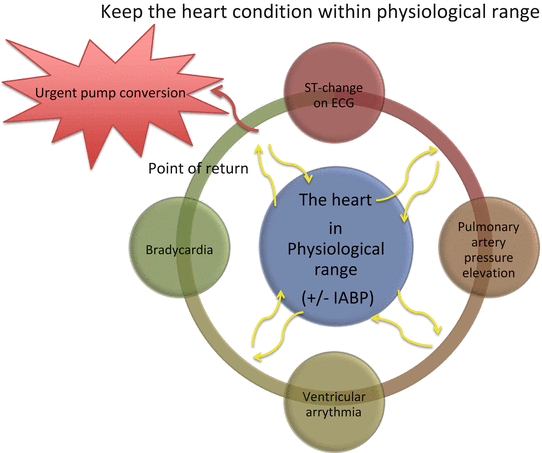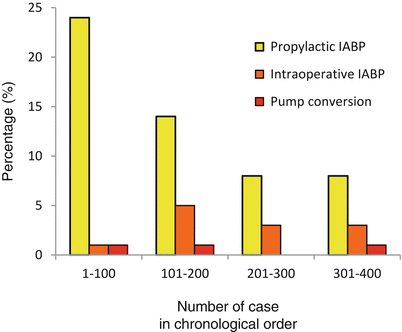Fig. 4.1
Routine off-pump strategy (See [A], [B], [C], and [D] in the manuscript)
[A]; At first, all patients who need CABG are candidates for OPCAB. The surgeon has to make first decision on selecting a patient who needs cardiopulmonary bypass by evaluating preoperative hemodynamic instability: Patients with hemodynamic instability such as cardiogenic shock with low systemic blood pressure (<80 mmHg), recent ventricular fibrillation (VF), or tachycardia (VT) undergo on-pump CABG. A heart with suboptimal performance must not have additional myocardial ischemia with coronary artery occlusion for anastomosis without hemodynamic support by cardiopulmonary bypass. All patients with stable hemodynamics are scheduled to undergo OPCAB.
[B]; Before induction of general anesthesia with tracheal intubation, the surgeon has to make a second decision on whether the patient needs a preoperative, scheduled intra-aortic balloon pump (IABP), the usefulness of which for OPCAB has been demonstrated by several clinical observational studies [19–22].
Tracheal intubation under general anesthesia possibly deteriorates patient’s hemodynamics, causing severe hypotension followed by coronary ischemia, bradycardia, arrhythmia, or cardiac arrest. Patients with poor cardiac reserve or an intolerable heart for systemic hypotension and coronary artery low perfusion should have scheduled IABP. IABP increases coronary artery perfusion and decreases myocardial oxygen consumption for improved cardiac contractility during OPCAB. Regarding cardiac reserve, two factors are taken under consideration: the degrees of coronary artery stenosis and cardiac contractility. Patients with critical left main disease (>95 % stenosis) or poor left ventricular function (0.35 < left ventricular ejection fraction) undergo scheduled IABP at our institute. Placement of IABP before tracheal intubation in the operation room is a simple and safe procedure: The patient on the operating table receives local anesthesia in the groin, followed by insertion of a 7-French IABP with a guide-wire technique through the femoral artery using mobile C-arm fluoroscopy with image intensifiers. We have determined from our experience that it is possible for this procedure to be performed within 10 min. Thanks to the recent innovation of IABP devices, complications such as aortic injury, thromboembolism, or femoral artery bleeding have not been observed in our series.
[C]; During OPCAB surgery, the monitoring of a patient’s hemodynamics is mandatory. OPCAB is a unique procedure where the surgeon is manipulating a beating heart, which, itself included, is maintaining the blood supply to the whole of the patient’s body. It is vitally important for the surgeon and anesthesiologist to keep a close watch on the cardiac rhythm, contractility, and myocardial blood perfusion while making best efforts to keep the beating heart within the physiological range (Fig. 4.2). At our institute, the anesthesiologist monitors the following: electrocardiogram (ECG), femoral artery blood pressure, Swan-Ganz catheter, and intraesophageal echocardiography. The femoral artery cannula can be used later for insertion of intraoperative IABP or percutaneous cardiopulmonary support (PCPS) if necessary.


Fig. 4.2
Principle to keep the beating heart in the physiological range during off-pump coronary artery bypass grafting to avoid urgent pump conversion
Any subtle sign of myocardial ischemia, such as bradycardia, change in the ST segment on ECG, elevated pulmonary artery blood pressure, and paroxysmal ventricular contractions (PVC), must not be ignored. Each event listed above should be treated immediately by the anesthesiologist with modification of the anesthetic drugs and administration of coronary vasodilator drugs and anti-arrhythmic drugs or by the surgeon, dislocation of the heart to the normal position, using an intracoronary shunt instead of simple coronary artery occlusion. Again, neglect of these subtle signs results in hemodynamic collapse followed by urgent pump conversion (Fig. 4.2). This topic is also discussed in the “Intraoperative Management and Anesthesia” section of Chap. 6 and the “Urgent Pump Conversion” section of Chap. 8 in detail.
[D]; In cases where intraoperative myocardial failure is found by combined systemic hypotension and elevated pulmonary artery pressure, it is imperative that the surgical team takes urgent action. The surgeon should call a perfusionist to set up the cardiopulmonary bypass or PCPS system immediately. The anesthesiologist should, by all means, try to maintain the heart beat and systolic blood pressure until the establishment of cardiopulmonary support. Urgent pump conversion with hemodynamic collapse and cardiac massage leads to unfavorable outcomes with extremely high incidence of stroke, renal failure, and death [23–26].
We do recommend “unhurried pump conversion,” but not “urgent pump conversion.” Although these two words have the same abbreviation, they are quite different procedures followed by quite different outcomes. For unhurried pump conversion, careful monitoring of the status of cardiac performance and ischemia is mandatory as described above. We experienced 4 cases of unhurried pump conversion in the first 500 consecutive OPCAB surgeries. One patient (case 1) suffered sudden ventricular fibrillation just after the opening of the pericardium. DC shock was applied immediately and successfully. The patient then underwent 4-vessel on-pump CABG without morbidity. Two patients (cases 2 and 3) suffered elevated pulmonary artery pressure and slight systemic hypotension with an elevated ST segment on ECG after completion of coronary anastomosis. These two patients underwent unhurried pump conversion and subsequent CABG. The remaining patient (case 4) with intramyocardial left anterior descending coronary artery suffered bleeding from the right ventricle. All of these patients underwent unhurried pump conversion with complete coronary artery revascularization without morbidity.
The impact of an “integrated coronary artery revascularization decision-making algorithm” on the rate of pump conversion in a surgeon’s learning period is summarized in Fig. 4.3. In the early stages of the learning curve, scheduled IABP was often employed due to the inexperience of the surgeon or high-risk patients for off-pump surgery estimated by anesthesiologists. The rate of scheduled, prophylactic IABP decreased as the surgical team gained more experience with OPCAB and reached a plateau after the team had experienced around 200 cases. What is significant about this is that unhurried pump conversion remained at a very low rate at 0–1 % throughout the learning period, even in the earliest stage. No urgent pump conversion by sustained hemodynamic collapse with major morbidity or mortality was observed in this series.




